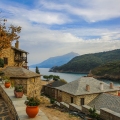In the quiet, tree-lined streets of the Flores neighborhood in Buenos Aires, an urban itinerary unfolds that links personal history with collective memory. Known as the Circuito Papal (Papal Circuit), this walking route explores key sites from the early life of Jorge Mario Bergoglio—before he became known to the world as Pope Francis.
Since his election in March 2013, interest in Bergoglio’s local roots has turned his modest biography into a cultural and spiritual itinerary. Unlike monumental pilgrimage routes shaped by centuries of devotion, the Papal Circuit invites visitors to engage with ordinary places where personal transformation occurred amidst everyday life.
Flores: The Cradle of a Public Figure
Flores, situated in the western part of the city, is the emotional landscape of Bergoglio’s formative years. Born here in 1936, he spent his youth immersed in a neighborhood rhythm defined by school, soccer matches, and community life. The area still retains the slower pace of earlier Buenos Aires, where bakeries, plazas, and churches punctuate the urban fabric.
Today, Flores marks the starting point of the Papal Circuit, attracting not only pilgrims but also tourists and locals interested in tracing the origins of a global figure who emerged from these streets.
Membrillar 531: Beginnings in a Working-Class Home
The first stop on the route is a house at Membrillar 531, where Bergoglio lived during his early childhood. The building, privately owned and closed to the public, nonetheless serves as a symbolic landmark. The family was of Italian descent, working-class, and devoutly Catholic. While access is limited to its façade, the house holds strong emotional weight for many who pause here to reflect on the intersection of private life and global history.
Basilica of San José de Flores: A Defining Moment
The most significant site along the route is the Basilica of San José de Flores. More than a place of worship, this is where, according to Bergoglio, a pivotal moment occurred. On September 21, 1953, at the age of 17, he entered the basilica for confession. What followed, in his own words, was a sudden and profound sense of vocation.
Decades later, he would describe the moment with characteristic simplicity: “Something strange happened to me in that confession. I don’t know what it was, but it changed my life.” For many, this statement elevates the site from a neighborhood church to a locus of quiet transformation.
Cornelio Saavedra School: The Early Foundations
Another key stop is Escuela Primaria N°8 Cornelio Saavedra, the primary school where Bergoglio began his formal education. It was here that he learned to read, write, and think critically—skills that would later shape his public communication style, known for its clarity and directness.
María Auxiliadora: Salesian Values and Influence
The adjacent María Auxiliadora parish and school, part of the Salesian network, also played a role in his development. As a student there, Bergoglio was influenced by the Salesian approach to education, which emphasized emotional connection, youth outreach, and a holistic understanding of human development. These formative experiences contributed to his later emphasis on inclusive leadership and community engagement.
Nuestra Señora de la Misericordia: Faith and Community
During his secondary school years, Bergoglio attended the Instituto Nuestra Señora de la Misericordia, also located in Flores. Though less prominent in public narratives, this institution reflects an important phase of his deepening involvement in parish life and broader community activities.
Informal Spaces and Local Lore The Papal Circuit also includes informal landmarks—cafés, bookstores, and public benches where Bergoglio is said to have read, met with friends, or simply observed the flow of everyday life. These locations, passed on through oral history and neighborhood anecdotes, provide a more intimate portrait of the man behind the public persona.
Familiar phrases often associated with Francis—such as “Pray for me” or “Reality is better understood from the periphery”—are frequently recalled in these places. Though now echoed in global settings, these expressions were born from a social and cultural context deeply rooted in the streets of Flores.
A Circuit of Memory, Culture, and Urban Spirituality
Far from a conventional pilgrimage, the Papal Circuit reflects an urban model of spiritual tourism that blends biography, memory, and social identity. It has become part of the city’s formal tourism offerings, with guided walks that allow participants to engage with local history and understand how faith traditions intersect with community narratives.
For many, the route offers not only a deeper understanding of Bergoglio’s life but also a meditation on how meaning can emerge from unremarkable places. Flores, with its middle-class heritage and communal character, serves as a poignant setting for such reflections.
The Enduring Message of Simplicity
What distinguishes the Papal Circuit is its lack of spectacle. There are no elaborate monuments or ceremonial spaces—only modest homes, schoolyards, parish benches, and shared memories. Yet within that simplicity lies a message about presence, humility, and the human capacity for transformation.
To walk this circuit is to enter a landscape where biography and city life converge. It is an invitation to observe how personal history unfolds not in distant sanctuaries, but in classrooms, plazas, and parish pews—spaces where identity, community, and conscience quietly take root.




